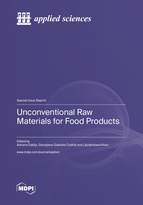Unconventional Raw Materials for Food Products
A special issue of Applied Sciences (ISSN 2076-3417). This special issue belongs to the section "Food Science and Technology".
Deadline for manuscript submissions: closed (31 January 2023) | Viewed by 35722
Special Issue Editors
Interests: food science and technology; food microbiology and safety; food biotechnology
Special Issues, Collections and Topics in MDPI journals
Interests: cereal products; rheological properties; sensory analysis; functional foods
Special Issues, Collections and Topics in MDPI journals
Interests: food technology; food quality; bioactive compounds; biopesticides; functional foods; food by-product and waste valorization; food safety; environmental toxicology; drinking water quality
Special Issues, Collections and Topics in MDPI journals
Special Issue Information
Dear Colleagues,
Nowadays, the food industry is constantly looking for new product ideas that follow global trends, producers combine innovation with tradition in the development of new products. The use of new raw materials in assortment diversification is a necessity imposed by the depletion of conventional raw materials, obtaining functional foods, dietary foods, etc. Researchers in the field are moving towards for the discovery of new raw material resources, for example, raw materials that can replace animal proteins and fats, sugar and salt, gluten from bakery products, etc. The use of these unconventional raw materials in manufacturing recipes is a great challenge for specialists in the field, but also in terms of consumer acceptability and legislation in force.
The large number of raw materials in the attention of researchers in the food industry leads us to believe that this Special Issue of Applied Sciences Journal entitled "Unconventional Raw Materials for Food Products" will be a success. We look forward to the work of colleagues immersed in investigating the nutritional, functional and technological properties of new ingredients that can be used in food manufacturing recipes, and we look forward to new perspectives and challenges in this field.
We cordially invite researchers to contribute original and unpublished research and review articles to be published in this Special Issue.
Prof. Dr. Adriana Dabija
Prof. Dr. Georgiana Gabriela Codină
Dr. Lăcrămioara Rusu
Guest Editors
Manuscript Submission Information
Manuscripts should be submitted online at www.mdpi.com by registering and logging in to this website. Once you are registered, click here to go to the submission form. Manuscripts can be submitted until the deadline. All submissions that pass pre-check are peer-reviewed. Accepted papers will be published continuously in the journal (as soon as accepted) and will be listed together on the special issue website. Research articles, review articles as well as short communications are invited. For planned papers, a title and short abstract (about 100 words) can be sent to the Editorial Office for announcement on this website.
Submitted manuscripts should not have been published previously, nor be under consideration for publication elsewhere (except conference proceedings papers). All manuscripts are thoroughly refereed through a single-blind peer-review process. A guide for authors and other relevant information for submission of manuscripts is available on the Instructions for Authors page. Applied Sciences is an international peer-reviewed open access semimonthly journal published by MDPI.
Please visit the Instructions for Authors page before submitting a manuscript. The Article Processing Charge (APC) for publication in this open access journal is 2400 CHF (Swiss Francs). Submitted papers should be well formatted and use good English. Authors may use MDPI's English editing service prior to publication or during author revisions.
Keywords
- unconventional raw materials for food
- trend in food
- new food product development
- food processing
- valorization of by-products
- trend in nutrition
- functional food
- foods for particular nutritional uses








